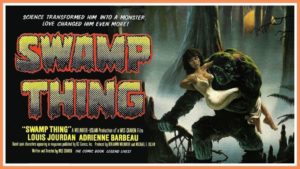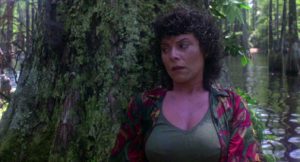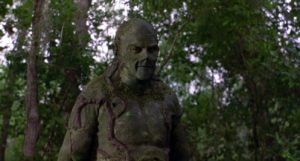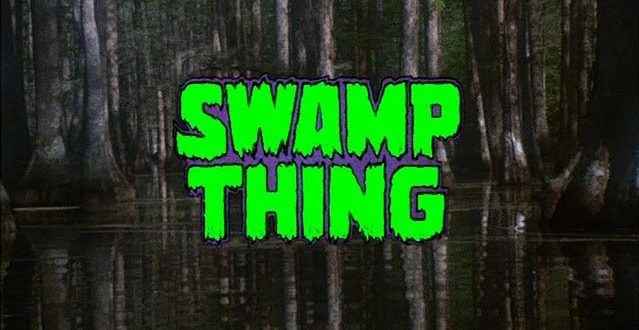Created by comic book gods Len Wein (who also co-created Marvel’s Wolverine) and Bernie Wrightson (illustrator of Stephen King’s Cycle of the Werewolf 1983), horror icon Wes Craven’s Swamp Thing (1982) loosely adapts the early part of their published run. Finding a balance between camp and horror, Craven (A Nightmare on Elm Street 1984) was able to make an atmospheric and fun picture despite a relatively low budget. With the film’s anniversary approaching on February 19th, I decided to revisit it.

Government operative Alice Cable (scream queen Adrienne Barbeau: Creepshow 1982) is the newest member of a secret research team based deep in a lush swamp. The project, headed by the determined Dr. Alec Holland (Ray Wise: Robocop 1987), has to do with the genetic hybridization of plants and animals. Holland sees his work as a solution for global hunger, though there are others who see its potential for more nefarious means.
It’s not long before malevolent and aristocratic businessman Anton Arcane (Louis Jourdan: Octopussy 1983) and his squad of mercenaries, led by Ferret (David Hess: The Last House on the Left 1972) and dim bulb Bruno (Nicholas Worth: Darkman 1990), attack the facility looking to obtain Holland’s research. Seemingly killed by the mercs in an explosion involving his new miracle formula, Holland instead is resurrected as a muck monster, the half-man/half-plant Swamp Thing (played by stuntman Dick Durock: Stand by Me 1986).
Cable goes on the run with a vital portion of Holland’s notes and is helped by Jude (Reggie Batts, providing deadpan comic relief in his only cinematic appearance), a kid who calls the swamp home. Will she escape? Will the now unrecognizable Holland get his revenge?

All the performers are game, tromping around a teeming, dense swamp. The location shooting by Robin Goodwin aka Robbie Greenberg (Butcher, Baker, Nightmare Maker 1981) is absolutely gorgeous and there’s tons of it. Most of the 91-minute runtime takes place out amongst dense foliage and murky waters. The picture has an almost lurid palette, nodding toward its four-color inspirations. Accentuating that effect is Craven’s choice to use ostentatious editing transitions in the form of various wipes.
The makeup and effects are fun, though some are fairly cheesy. The Swamp Thing and Arcane Monster suits are very cool but are obviously limited by the budget. My favorite effects sequences are the highly impressive full body burn toward the end of the first act and the arm regeneration scene near the beginning of the third act.
I’ve mentioned camp and cheese, but Craven still manages to insert some disturbing elements like the dinner sequence with Bruno, keeping the film firmly in the horror milieu. The score by Harry Manfredini (Friday the 13th 1980) also helps in this department, providing an eerie soundscape that compliments the isolation embodied by both the swamp and the titular creature.

Pulling double duty as writer and director, Craven maybe dips a little too hard into camp, thinking that emulates comic bookiness. Nevertheless, his Swamp Thing is still briskly paced fun. The Swamp Thing property became an unlikely success in the ‘80s and ‘90s, spawning a more self aware sequel (fan favorite Jim Wynorski’s The Return of Swamp Thing 1989), a live action TV show, and an animated series.
In the comics world, arguably the greatest scripter of all time, Alan Moore (Watchmen 1986-87), redefined the character in the mid ‘80s, spring boarding the eccentric bearded Brit into comics megastardom. The most recent TV series, which was unceremoniously cancelled due to a behind-the-scenes mishap involving improperly filed tax paperwork, mines both the Wein/Wrightson and Moore runs.
As it stands, though, Craven’s film is probably the best representation of the original version of the character as conceived in the comics. Swamp Thing comes recommended with some small caveats.
 PopHorror Let's Get Scared
PopHorror Let's Get Scared




